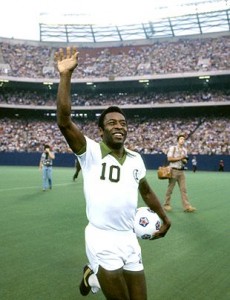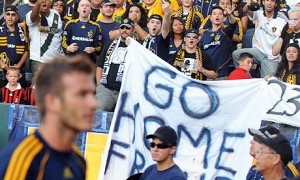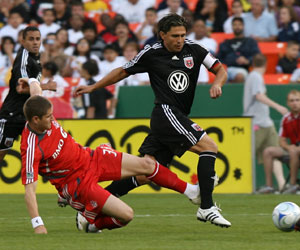Eight Ways To “Americanize” Soccer For American Fans

Most Americans only care about competitive soccer when it is time for the World Cup or Olympics. Would some minor "tweaks" make the game more appealing on a regular basis?
As Major League Soccer begins to wind down its season and Women’s Professional Soccer is two months beyond the end of their inaugural season, it is time to reflect on the status of soccer in the United States and do a little diagnosis and prognostication.
There are critics who assert that low scoring matches, ties, and no-scoring matches as outcomes that must be changed in order to save the American game. Some have suggested enlarging the dimensions of the goal, shrinking the size of the pitch, and shortening the length of the match, using PK’s as tie-breakers, and calling more penalties in the box as his key solutions. In other words, tweak the game in order to increase scoring, and to eliminate ties as final outcomes.
The basic premise of such arguments, that soccer is not consistent with American sports culture in key aspects is a good one. Beyond that, the sport’s critics mostly miss the mark.
Changing the physical dimensions of the pitch or the goal, or the length of the match would diminish whatever international credibility American soccer may have, and make it more difficult for American players to adapt to the international game.
It would also alienate American soccer purists (of which there are more than some critics might think) who make up the fan base of both leagues right now, and are essential to both leagues’ success.

Pele increased the visibility of soccer in the United States during the 1970s, but the interest in the professional game was short-lived.
It is also important to note that unlike most home-grown American sports, the act of scoring is not the key focus of the game, but even in American sports, there’s more to the game than scoring.
First of all, the first and most American of all home grown games—baseball—is slower and often as low scoring as soccer. The only difference is that games can’t end in ties. Given that some games go into 15 innings or more, it might actually improve the game if ties were allowed.
In American football, a well-managed drive to the red zone is something wonderful to watch and while a team’s failure to convert a red-zone possession into points on the board is frustrating, the game is no less exciting because the goal line wasn’t crossed.
If there are brilliant runs and beautiful passes as offenses move the chains, an eventual field goal or touchdown is icing on the cake. But even without the icing, the cake is very tasty. And from a defensive perspective, a goal line stand is almost as thrilling for fans as a touchdown.
In basketball, a powerful shot block is as incendiary to the fans, and as potentially momentum-shifting as a three-point shot.
In soccer, what happens between the goals is even more significant than basketball or football. Watching an attack begin to form and gather steam, watching plays continually re-shape to adapt to defensive stops, is as thrilling as it is visually beautiful.
A power shot that barely misses, stops hearts on both sides of the pitch.

Instead of trying to make a big splash by bringing in international soccer stars like David Beckham, soccer in the U.S. might be better served to make minor alterations to the game that make it more enticing for American fans.
A dramatic save often earns the applause of the opposing fans as well as the supporters, due to the difficulty of the stop and the beauty of the physical execution.
So in my opinion, it isn’t scoring or the lack of which that impairs the growth of American soccer. It is more subtle cultural idiosyncrasies that could be tweaked without destroying the integrity of the game.
In other words, we can Americanize soccer in ways that will raise international eyebrows but not evoke international disdain, and in ways that don’t make it harder for our National teams or our home grown players to succeed in international competition.
I will submit my own suggestions of rule and policy changes that would increase the marketability of the MLS and WPS in the United States and Canada without altering the fundamentals of the game.
First: Timekeeping
To maintain credibility with local soccer purists and especially with the international community the games must remain 90 minutes long. But…we can keep the official score on the scoreboard, and count down the time by period rather than counting up by entire game length.
Americans are used to getting the actual time on the score clock, and they’re used to counting down. This cosmetic change would do nothing to harm the integrity of soccer and would make American fans much more comfortable.
Second: Substitutions
We’d hear a little more noise from the purists about this one, but they’d get over it. I’d be in favor of allowing more than three substitutions and allowing players to re-enter the game after being subbed out. This, again, would make soccer more like the rest of our sports, and would ensure that legs remain fresh ’til the end.
Third: Team Names
Purists love it, but team names that include FC anything just don’t make sense to American fans. It would be up to individual franchises to evaluate whether or not to change such names as FC Dallas, Toronto FC, Sky Blue FC or FC Gold Pride but teams with names that can be personified by a mascot play better in America.
Fourth: Uniforms

Would Americans care more about soccer if the uniforms didn't make the players look like walking advertisements?
“American” sports have prominent team logos on their uniforms. The MLS and WPS should consider scrapping the international style uniform in which the only prominent graphics are commercial logos and in which the team insignia can’t be seen without binoculars.
I understand that corporate sponsorship is crucial to the financial survival of soccer in the US, but I would limit corporate signage to the lower back of the jersey, and make the team logo prominent on the front of the jersey, similar to the style of the original Chicago Fire uniforms.
Chicago had it right in the first place. More recently they have gone the wrong direction on this point.
Fifth: Tie Breakers
On this point I agree with Mark Jones. Americans like resolution. We’ve added tie-breakers to football and hockey, much to the betterment of both sports. A shoot out at the end of a deadlocked soccer match would add a great deal of drama, and hopefully a great deal more butts in the seats.
Sixth: More Liberal Use of PK’s
Jones may have a point here as well. It wouldn’t even require a rule change to simply instruct the referees to call more PK’s for fouls that occur inside the penalty box.
I wouldn’t increase the size of the box, as Jones suggests, for the same reasons I wouldn’t change any other dimensions on the field. But calling more fouls in the box could be done, and in so doing, it would increase American interest.
Seventh: Expansion
Jones lauds the MLS for rapid expansion. It could be argued that expansion dilutes the quality of play, and where soccer is concerned, many would say the level of play needs improving, not diluting; however I agree with him that smart, strategic expansion will increase the quality and quantity of soccer fans in North America.
I would recommend that expansion continue in mid-market cities that don’t have many or any other major league offerings, and if possible, where soccer is already strong.
Mid-market venues with no other major league teams to get behind would be more likely to fill a 20,000 seat (or larger) soccer stadium consistently than even the largest metro centers with numerous other franchises and sports to compete with.
Last: Inter-League Cooperation and Coordination
MLS and WPS teams in the same city should establish formal agreements to coordinate their schedules to maximize attendance for both teams. Whenever possible both teams should not play at home in the same week.
This would eliminate the competition between the two home teams for attendance on the same weekend, and would also serve to offer major league pro soccer weekly or nearly so in every two-league venue.
Combination tickets packages could be sold beginning with double season tickets, and with ten packs, six packs, four packs, even two packs that would include one game for each team.
Discounts of 10-40 percent could be offered for two-team combos. The additional attendance that would be generated for both clubs would more than compensate for the discounts. The energy generated in the stands by larger crowds would enhance the fan’s experience and the team’s performance.
John Wingspread Howell is a novelist, sportswriter and columnist, and publisher of the online magazine, Underdog Sports (www.underdog.sports.officelive.com.). He is a regular contributor to Sports Then and Now.
John,
You analyzed it all very well, and then fell back to ideas that were crushed 10 years ago…
There is plenty of excitement during a match, just like in other sports. The reason the average American fan doesn't like soccer is that he or she didn't grow up with it and so doesn't "understand it".
If you can't recognize a great cut or run or buildup, you won't be able to appreciate it. This is no different from any other sport. In fact, I think that the fact that Americans play so many different sports will allow them to "get" soccer more quickly – but they need some help.
I think the key to making the game more popular is announcers and analysts who are capable of doing what John Madden did in football – draw the lines, show the plays, make it exciting in a way that you can learn the game.
IMHO 😉
This article is a waste of bandwidth.
Soccer is growing in popularity, no need to pollute it with the WORST in American sports.
Its not 'Americas' game, it is the worlds game. Get over it and move on.
There's nothing wrong with the beautiful (and much more global than American Football, Baseball, and Basketball) game. Americans (which I am one) wrongfully promote raw physical strength as a skill in many of its sports. Attempting to Americanize a game that has barley changed in hundreds of years will still not improve its viability to Americans, but will instead turn the other nations of the world more against us along with driving more young American Soccer talent out of the country thus making MLS worse.
This article is a joke, as you are shielding the real problems with American soccer by trying to Americanize a game that cannot be Americanized. If you don't like what you see, don't watch it. I don't watch American Football or Basketball, and I barley pay attention to Baseball anymore. The American Franchise way to run sports has its ups and downs, but it is definitely not the best way to do business.
You forgot to mention to encourage players to scratch their ass and crotch, chew gum, sport big bellies, wear lots on unnecessary gear … and of course take steroids
a few problems with your "solutions":
1. Timekeeping – no match is ever 90 exactly. theres always stoppage time thats added on and the game only ends when the ref decides to end it. you cant say that people count down the time when you dont know exactly when the end will be. btw the count down clock was originally used in the beginning of mls. wonder why they changed it…?
2. Substitutions – soccer actually does have free substitutions: INDOOR soccer does. soccer players are some of the best and most physically fit atheletes in the world. any of them want to be out on the pitch the full 90 – and 8 of the 11 do evry game. if you want free subs switch to the soccer with walls.
3. Team Names – so the average american cant understand what FC means? really? were that stupid? give people some credit here. even if you told the most hardcore nfl fan that FC meant football club theyd understand it meant soccer. dont insult peoples intelligence – nascar does that enough.
4. Uniforms – teams have only been wearing ads on the front since 2007. 2 whole years. before that from 1996 on when the league started teams had their names on the front. if you really want a 'walking advertisement' go watch more nascar. ads are a part of evrything. until you have teams like 'toyotas fc dallas' or 'progressives columbus crew' its better to have them on the unis. otherwise you end up with commercial breaks evry 5 min like you do in most evry other sport in america.
5. Tiebreakers – again you must not be one for the history (short as it may be) of mls. there used to be shootouts and golden goal rules. wanna take a gues why they got changed too? it drove away us 'purisits' and didnt draw in the typical american fan like youre suggesting it will. and i dont see it as a 'second time is better than the first' deal. so dont expect this anytime soon.
6. More PKs – so basically you want to turn the game into something not decided by the players but ultimately how generous the ref is with his whistle in the 18? dont mlb/nfl/nba teams and fans hate when officials end up calling the outcome of the game? so your saying lets do this in mls. besides the fact that this is just plain stupid, youre only gonna get a few refs at most who will actually follow this. they all have their own level of whats a pk and what isnt. the leauge trying to interviene and tell them to make a game-alterining call like that more consistently will not only alienate the players but the refs. have fun with that.
7. Expansion – ok really youve got this fancy tool called the internet and you cant look up the history of soccer in america? if you could youd know that there used to be this league called the NASL that tried to expand and brought in loads of teams in a short amount of time. as i recall the league didnt last too long after that. mls is expanding right now – they plan on having 20 teams by 2012, and i think thats just the right number. more teams means adding more games to the almost 50 games they already play, not to mention tourneys like SuperLiga, CCL and the Open Cup – that could end up being close to 75-80 games, and you want more??? gl w that.
8. Inter-league co-op – this only works when youve get more teams in the WPS. since theres only 9 teams – and only 2 any farther west than Missouri, theres only 20 games in a season. the WPS right now is more of a special event rather than a consistent thing. give it some time to develop in to league w more variety – i.e. longer season, more teams – particularly out west. womens leagues (outside of the W-League) havent been successful and collasped fairly quickly. give this one a time to grow before you start force-feeding it to the mls fans.
in conclusion, i ask that if you ever write about mls again (god forbid) then please take the the time to do your homework, look at the history and how we got here today, then start offering ''help" as to how we can 'fix' mls. otherwise please shut up and leave us purists and our evil evil desires of playing soccer the way it was meant alone. we dont need to be insulted by the likes of you
I don't know that the game needs many on field changes, but the jerseys are the one thing I would definitely change. Walking billboards are fine for NASCAR because you can't see the drivers and at least the numbers are easy to see around all the ads. But in soccer to replace the team name with a product name makes the uniforms look silly. If they have to wear advertisements, make them small like in tennis and some other sports.
Thanks for your article!
I have been playing soccer for my whole life, and some of the changes you suggest are intriguing. I'm not sure if they would work or not but it would be interesting to see. Apparently, I'm the only one who is giving any thought to this article, but ignore the haters and keep up the good work!
Great post, happy summer to you.
I agree with everything this guy wrote but I would also make the net bigger. Jack Cashill wrote an excellent piece on this back in 2010. Here is the link: http://www.wnd.com/2010/06/167681/
Pick out a complete-size table if your recipient has a devoted sport space.
For players 23 or younger, there is the PDL League. To play this and other soccer games for kids click
on the following link.